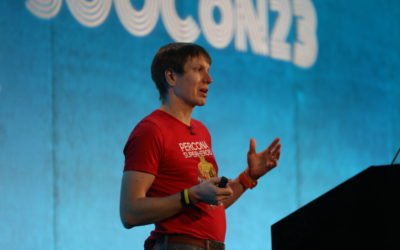Successful Open Source Communities span the globe and with people speaking different languages and located in different timezones, the “Global Community” is surely going to be based on asynchronous communication. Let’s look at the tools that exist for such Asynchronous conversation and their benefits and drawbacks.

Blog
Of course, your community should have a blog, it is a great way for community leaders to broadcast their message, yet even though you might be getting some comments it is more of a one-way communication tool, rather than the space where all community members can participate as equals.
Social Media
Social Media should also be part of the story – you should have a Facebook Page (or a few), LinkedIn Organization Profile, Twitter, Instagram, etc. It is great to be used as a communication tool which makes it easy for your community to engage, however, it gives a lot of control to social media sites – you often do not have control over how information is presented as well as Social Media sites, not you, control who gets to see your communication. For example, if you send your tweet, chances are that it will only be shown to a small fraction of those who follow you. However, this is changing – solutions such as Telegram feeds allow you to subscribe to and receive all posts in the feed, rather than pre-selected by the social network and are therefore a better tool for engaging with the community. Many forms of social media, like blogging, are largely one-way communication.
Email List
Email Lists served as a foundation for many early Open Source Communities – Linux Kernel, MySQL, and PostgreSQL in its day had a very engaging mailing list-based community. PostgreSQL still relies on mailing lists for its development process. Yet a lot of younger developers can consider mailing lists heavy and outdated. While starting the Mailing List those days may not be first priority, email integration should be – Newsletter, blog post subscriptions, forum updates, and GitHub notifications can be fantastic to drive engagement.
Slack, Discord, IRC, etc
Some Open Source Communities have great success with these real-time communication tools. These are great for growing your community by providing beginners with real-time assistance for their questions. The downside of those tools is members expect real-time responses, and if you can’t provide them they may be disappointed. These solutions work very well for larger, active communities when someone will provide real-time response most of the time or require significant investment with someone’s job being responding to messages in real-time, which for engineers can be quite disruptive. Such channels work very well though at conferences and online events, where everyone can be really paying attention.
Whatsapp, Telegram, etc
Over the last few years, you can find a fair amount of mobile-centric communities on WhatsApp, Telegram, and similar tools. Generally, though these tend to be smaller communities with little need for structure and brief communication. For Open Source Communities with their more elaborate needs, I think they can work best as a secondary channel, for example, the channel created for local community members who periodically get together or coordinate activities from community members attending some major conference.
GitHub Issues
GitHub and GitHub issues in particular can be great collaboration tools for developers – it is great for some areas of the community – filing bugs and feature requests, discussing proposals, etc. Github pull requests are pretty much the industry standard for proposing your code for inclusion in the project. Yet it does not cover other needs, such as getting help and discussions very well. Similar to social media you also have limited control over the look of those pages.
Forums
Forums are also the old format, which was iterated and re-invented over the years. StackOverflow you may argue is a Forum site structured around questions and answers. There are many great things about forums. First, you typically own your Forum, meaning you have control over design and content policy, can decide how to notify members by email, etc. Second everyone can equally participate – creating new topics and responding to them. At the same time, you can empower some of the community members with additional powers such as moderation or Gamify Forum experience with badges, etc. You have a lot of control too – it is easy to create categories in which only some members can post even though only some members can access. Because a forum does not imply real-time responses it can be easier on your team – if you have someone on your team reviewing posts in the morning and in the afternoon to see which posts were not handled organically it will be good enough. Another great difference between Forums compared to some other forms is persisting content which gets indexed by your search engines and becomes a fantastic knowledge base for your community and a source of new members.
Youtube/Podcast
Podcasts or webinars can serve as a central activity – a recurring event that fosters community cohesion. It is also a platform for core members of your community to express their ideas and expertise. These core members are typically the most proactive and professional individuals, and they require a space for self-expression. Ultimately, they are excellent tools for learning and “live” communication, particularly when primary communication occurs online.
What tool or tools should you use as the foundation of your online community?
It depends. Typically if your Open Source Project is hosted on GitHub it makes sense to use its development tools for development, to minimize friction. Blog with Social Media integration is a great way to get your project message out. Some form of Forum is fantastic for problems and discussions you want to be searchable and when your community is small there will not be organic real-time communication. Slack/Discord/Telegram can be very helpful during online events, though if you are planning to keep it as a permanent communication channel I would recommend ensuring there is a commitment to handle them.
Okay, and how can you figure out which of these tools your community requires?
After all, managing all of them is a task for a whole team, not just one employee who takes on the role of a community manager. You can rely on Underdog Consulting to handle the maintenance of your community’s infrastructure. We will analyze the community’s structure based on its goals and objectives, concentrate on the essential channels, and guarantee their continuous operation. All you’ll need to do is focus on the content aspect.
About Author
Peter Zaitsev
Founder, Open-Source Advocate, Technologist, Boards Member, Advisor & Mentor
Peter Zaitsev is an entrepreneur and founder of Underdog Consulting. As one of the foremost experts on Open Source strategy and database optimization, Peter leveraged both his technical vision and entrepreneurial skills to serve as a co-Founder, Board Member & Advisor in a range of open source startups such as Percona, Altinity, FerretDB, etc. Peter is a co-author of High Performance MySQL: Optimization, Backups, and Replication, one of the most popular books on MySQL performance, and the author of hundreds of articles on a variaty of topics.
Related posts
How to Write a Great Abstract for Tech Conferences
Your abstract is more than just a summary of your talk; it’s a strategic tool to attract the conference audience and help organizers place your session within the event’s agenda. A well-written abstract sets expectations clearly and entices attendees by highlighting the relevance and potential impact of your topic.
Speaker Presentation Skills: Making a Lasting Impression
Whether you’re gearing up for a crucial business pitch or a talk at a major conference, the art of delivering a compelling presentation is essential. Here’s a guide with practical tips to ensure you nail that first impression and keep your audience engaged and informed.
How to beat ChatGPT in Content Marketing
You may have noticed an increasing amount of content generated with ChatGPT and other LLMs (Large Language Models). If you’re practicing Content Marketing the competition might be increasingly hard.
Note though – what LLMs are especially good at is parroting the information already available somewhere, in particular, good (in my experience) creating content that reads well but has little information density.
Getting the Most Out of Online Events
Online events are a great way to connect with people. They’re cheaper and reach more people than in-person events, but often we don’t fully understand or use their value.
Make different mistakes, ask different questions
When you hire someone, would you want them to never make any mistakes? If you answered yes, think again! The only way to never make any mistakes is never to do anything, and obsessing with mistake avoidance will push you towards solutions that are likely to be inefficient for most situations. This also likely means avoiding going out of your comfort zone and trying new “risky” stuff which slows down learning.
Efficient Speaking Strategy
Speaking at the conference is a great way to establish “Thought Leadership” in your organization as well as build your personal brand and reputation. It can be a great way to market your products to engineers as well as showcase your company as a great place to work helping with recruiting.
Becoming In-Demand Speaker: Five Strategies for Tech Conferences Success
Becoming a speaker at professional tech conferences and sharing your expertise with the public is one of the quickest and most effective ways to build personal branding and career. For companies, it is a great way to be exposed as a thought leader which can help with marketing products and services and attracting awesome engineers. However, how do you secure speaking opportunities competing with market mastodons, especially at conferences that do not have an open Call for Papers?









0 Comments